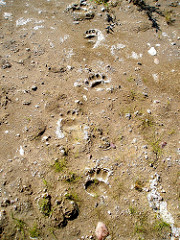
B.C. archaeologist Shannon Cameron
BC archaeologist Shannon Cameron takes precautions every time she goes to work in the woods. But one day, she and her coworker met a bear whose curiosity outweighed his instinct to avoid humans.
“He was within 15 feet and he was standing up on his hind legs and huffing. There’s specific noises and facial expressions they make when they’re going to charge, and my crew member and I were doing everything we could to look as big as possible,” she told me.
“We were waving our arms and clapping and hollering and setting off bear bangers and bear spray and finally the bear decided he didn’t want anything to do with it and he turned around and walked away. That’s as close as I ever got.”
As archaeologists, Shannon and her colleagues look for evidence of past human activity on pieces of land used by foresters, geologists, and other industries. The first thing they do – with respect to wildlife – is make a lot of noise to announce their arrival. They bang shovels and do “bush calls” to let animals know humans have entered their territory. Once they get to work, they keep talking to one another if they are spread out, to keep their presence known.

Bear tracks. Photo supplied by Shannon Cameron
“You’re pretty focused on what you’re doing on the site, trying to get it done,” Shannon said. “There were things you had to do in that environment, like not bringing certain foods like chicken wings or ribs in your lunch and making sure all your food is well-sealed.”
Shannon said they also carry bear bangers (i.e. small explosives that scare bears away), bear spray, and a rifle for shooting into the air. She said workers in the area – foresters, geologists, biologists, and archaeologists – inform each other about animal sightings.
“Knowing there’s a mama bear with cubs in the area is the most concerning thing because you know they will be very protective and they’ll have bigger boundaries than they normally do,” she said.
Shannon said awareness is the best prevention.
“It’s being aware of your surroundings and trying to be respectful of it. If you do that, you really minimize your chance of having those close encounters,” Shannon said, describing how you can keep the environment safe for other humans who arrive after you.
“You don’t leave all your food wrappers or feminine hygiene products laying around. If you minimize your impact and let everything know where you are in the bush, you’re probably not going to have that many incidents.”
Even one close-up incident would be more than enough for me, but luckily there’s more information on minimizing the risks of bears in the woods. Check out Beware of bears and be prepared and Training of workers with respect to bears.


